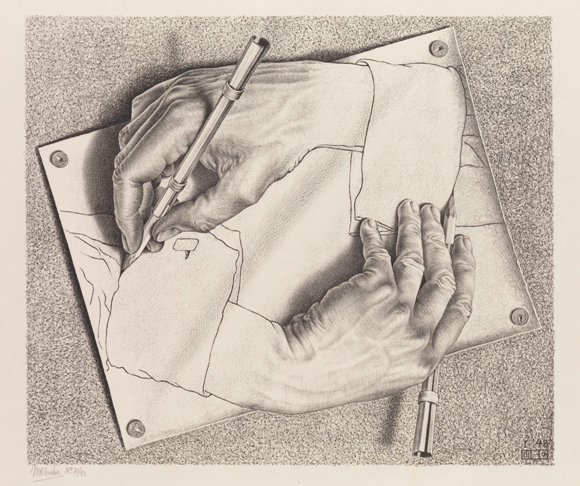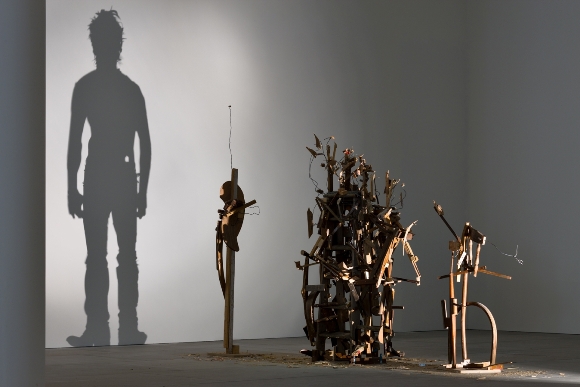Acquainting my 6 year old with the conventions of museum visits has been, shall we say, challenging. Between constantly barking at him to respect the reverential silence (yes, I recognise the irony) and constantly reminding him “don’t touch!” I’d begun to worry that I might be putting him off High Culture even before he had the chance to make his mind up for himself. So, the wording for a press tour of the new exhibition at the Israel Museum – “you are welcome to bring your children” – presented as both opportunity and challenge: can one differentiate the pleasures of culture specifically for children without losing its essential essence?

© 2013 The M.C. Escher Company-The Netherlands. All rights reserved.
ArTricks, running in the Ruth Youth Wing for Art Education at the Israel Museum through February 2014, is built around around tricks of the mind – the gap between how we perceive the world and how it really is. The centrepiece of the exhibition is a hub of 30 works by the illusionist M.C. Esher, whose tricks of the mind – the never ending staircase, industrious little ants marching along to eternity on a mobius strip – have tickled the imagination of countless teenagers. One appreciates that this choice of centrepiece is primarily pragmatic, given that the museum has a large collection of Esher’s original prints. I did think that the cluster might be a bit overwhelming, but many of the small guests were sufficiently intrigued as to try and physically conceptualise the impossible (cue choruses of “don’t touch!”).

The principal component of mind tricks in general, and ArTricks in this particular case, is exploiting the gap between mental expectations and reality. We don’t, for example, expect a sliced lemon to reveal a side of beef (Roni Reuveni’s Still Life) or to find a kit of pigeons leaving their deposits along the walls of the hallowed sanctum ( Maurizio Cattelan’s Tourists). But I had the sense that these appealed to to me more than they did to my companion for the day, who merely pointed and giggled and wandered off.

ArTricks works at its very best where it captures the balance between information and entertainment; education by stealth one might say. Tim Noble and Sue Webster’s light-and-shadow sculpture Youngman, clever and intriguing and carefully thought through, lit a spark of investigative curiosity. The fascinating yet disorienting experience of Gigi Scaria’s Elevator From The Subcontinent prompted a long conversation about being the same but yet different, an unexpected but very much appreciated turn from what was first and foremost a sensory experience. But the absolute highlight was the room dedicated to the trompe l’oeil of the late Buky Schwartz: ribbons apparently defying gravity with the help of a mirror, the genuinely disorienting mirror and gravel arrangement of Changing Square, and the wonderful interactive video installation The Chair. I had to physically drag him away eventually, literally: this was most certainly not what I’d expected.
Adults, I think, treat museums primarily as a intellectual experience: we hunt, usually in packs, for sparks of enlightenment. There’s nothing wrong with this, but it was fun to see kids engage with the exhibit from a different perspective, one that placed the emphasis on the instinctual, on experience rather than explanation. In the same way that jokes lose their potency once you have to repeat the punchline, ArTricks works best as an unmediated and immersive experience. I did wonder whether curator Daniella Shalev might have missed a trick by not making more explicit connections between the exhibitions and similar works elsewhere in the museums collections. But maybe that’s not supposed to be the point. My child insisted on taking the exhibition “catalogue” – in fact a series of prints – the next day to school, to show his friends what he’d been up to on his day off. You can’t really ask for much more than that.
ArTricks is on view at The Israel Museum until February 15, 2014. True or False? a series of summer events and activities will be co-ordinated in conjunction with the exhibition, including:
A Feast of Illusions
Tuesday, July 30, 5 pm, 9 pm
Musical performances with surprising instruments, a special effects studio, the secrets of bodily movement revealed by a mime artist, tricks in nature, deceptive photography, and illusion activities from the Bloomfield Science Museum in Jerusalem, including living statues, humorous illusions, and more.
Youth Wing Activity Yard: A Yard Full of Illusions
July: Tues 4–7 pm
August: Sun, Mon, Thurs 10 am – 5 pm, Tues, Wed 10 am – 7 pm, Fri 10 am – 1 pm
Take a peek into an Ames room with its illusion of depth, discover what happens when you cut a Möbius strip, draw a hand that becomes three-dimensional, look at yourself in an infinite mirror, and more.
Movie Studio Special Effects
August: Thurs 4 pm
Ages 6 and up | NIS 25
Youth Wing Auditorium





